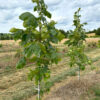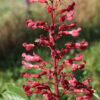The famous forager and naturalist Euell Gibbons says ‘the common Elderberry, known to botanists as Sambucus canadensis (sic), is one of the most abundant, most useful, most healthful, yet most neglected of our native wild fruits.’[1]
- Ripe elderberries
- Elderberries can be dried & made into a healthy winter tea
He urges everyone to utilize the dark blue-black berries as, when you harvest them, you are ‘dropping health into that pail’. Indeed, the benefits of elderberry seem endless, from treating colds and hay fever, to helping with diabetes and weight loss and generally fighting infection and inflammation. The berries are packed with vitamin C and flavonoids, those compounds which support our overall immune system. Science is finally catching up to the ancient wisdom of indigenous people who have used native plants for medicine for centuries.
This may be a good winter to stock up on natural tonics as the Old Farmer’s Almanac is calling for cold and above average snowfall for the Appalachians. The alcoholic drink sambuca is made by infusing anise and elderberries into alcohol.
However, clear warning: the raw berries are completely unpalatable/mildly toxic to humans so must be cooked or processed (made into wine, jams/jellies, pies, tea, etc.) in order to be ingested.
Too, another highly toxic dark berry also ripens the same time of year as the elderberry – those of poke salet or pokeberry (Phytolacca americana) so take care to obtain a positive identification for any wild edible before eating it.

Even elderberry flowers can be made into a pale yellow wine – called “elder blow wine”[2]
It is good to scout out the location of elderberry before they get completely ripe as birds also relish the berries straight off the bush. The large shrub (or small tree) tends to grow abundantly once established so, given plenty of room to spread, there will likely be enough berries to both harvest and share with wildlife.
The shrubs grow about three to ten feet tall (but can reach 20 feet), and are most happy in moist, open areas where they can get plenty of sunlight. Not overly particular in their location, they can adapt fine to disturbed areas, streamsides, woodlands and fields.
Elderberry provides a great backdrop to native plantings and grows well with taller wildflowers like ironweed, Joe Pye Weed and New England Asters.
Shorter native wildflowers such as false blue indigo (pictured below in bloom) Echinacea, Rudbeckia, cardinal flower and bee balm provide a splash of color for the front of a native border which utilizes elderberry in the background.

In more formal landscapes, they can be trained into a hedge but this limits their berry production
Chris Anderson, Executive Director
White House Farm Foundation
1917 Kauffmans Mill Rd.
Luray, VA 22835
www.whfarmfoundation.org
[1] Stalking the Wild Asparagus, Field Guide Edition, Euell Gibbons, David McKay Company, inc., New York, 1962,p.87
[2] Using Wayside Plants, Nelson Coon, Dover Publications, Inc., New York, 1957, p. 158.







